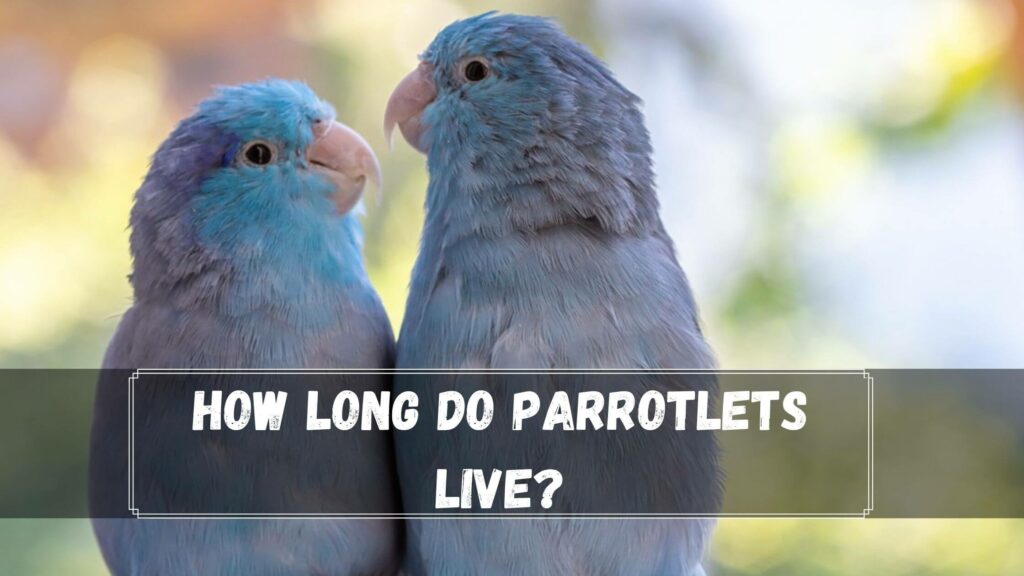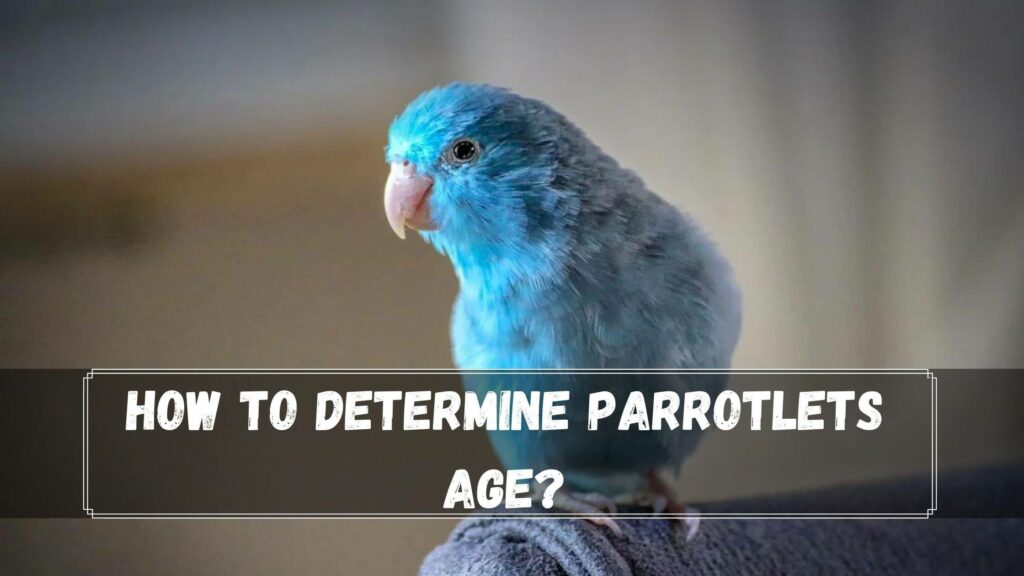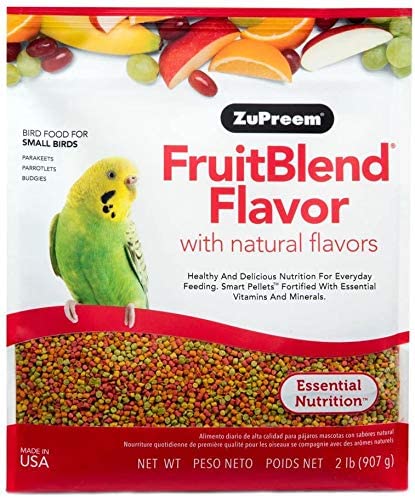
Parrotlets are fascinating and unique parrots made for lifelong companions. Even though they are not considered exotic species, they make excellent apartment pet birds. In this article, we will talk about how long do parrotlets live, both in captivity and in the wild.
I will also discuss the average life cycle of parakeets, including identifying their age.
How Long Do Parrotlets Live?

Parrotlets usually live for at least 15 years to 20 years, depending upon many factors. They are known to survive at ten years only in the wild due to predation and scarcity of food. In captivity, they often live up to 15 to 18 years on average. In the forest of Mexico and shrublands of south & Central America, parrotlets usually live around 10-12 years if they don’t encounter natural predators like eagles, hawks, owls, and giant snakes.
How To Determine Parrotlets Age?

If you have recently bought a parrotlet from a breeder and don’t personally witness the hatchling of that pet bird’s egg, you are less likely to find out the actual age. However, you can ask the breeder to tell you the age of your parrotlet.
As with parrotlets, there is no way to determine the actual age of a Juvenile or adult parrotlet. Therefore, here we will talk about the change of appearance that growing parrotlet exhibits to understand the expected period of your bird. Most adult parakeets will have their full plumage and colors between 3 months to 1 year old, with a few exceptions.
The information mentioned below is just a guess according to their plumber’s age or color change. Unfortunately, it is impossible to determine the actual age of wild-caught parakeets or the one bought from the Pet store.
Hatchlings
Hatchling parrotlets are usually born without senses and feathers, and they tend to be reliant on their parents for everything. Mother parrotlet can live anywhere from 3 to 8 eggs in a clutch. Male and female parrotlets take turns keeping the eggs warm.
Most baby parrotlets will have growing feathers by the end of the first week of hatchlings’ life. One-week-old parrotlets’ ear flaps will begin to open also. By the end of the first month of life, all hatchlings will fully use all of their senses. You will notice extra feathers to boot as they complete one month of their life cycle.
Young Ones
Parrotlets tend to be curious, and therefore, you are likely to notice young parrotlets being incredibly endearing and curious. In the first three months of its life, your parrotlet is expected to grow more feathers while weaning food supplies from its mother. The process of parrotlet growing its feathers is called fledglings.
Fledgling is typical in all baby Birds. Beginner is when baby parrotlet grows all of the feathers it needs for a successful flight. Once your parrotlet feathers are developed, they have learned to search for food independently. Hence, most young parrotlets will show independence by learning how to fly.
Baby parrotlet under the six-month mark will still have issues in learning this critical process of flying. If your parakeet is struggling to pass or has just started to fly, maybe it’s a 4-9-month-old Bird.
Adult Parrotlets
Full-grown parrotlet that has reached sexual maturity is considered an adult. However, it can differ from bird to bird. Most parrotlets reach adulthood at the age of 8-12 months old. By this point, your parrotlet is likely to be able to spread its full feather on display. Adult parrotlets are also expected to fly with the mighty wings that are grown in the process of fledglings.
Adult parrotlets still need companionship despite their newly found independence. Being social birds, parrotlets need to socialize for the rest of their life. The socialization could be with its human companion or with other Birds. Any interaction will be a positive thing for parrotlet.
Consider feeding your adult parrotlets a structured but varied diet. Always consider offering plenty of toys to play with your parrotlets. Providing mental stimulation and lots of exercises through toys is key to extending a parrotlet lifespan. You should also seek specialized Avian veterinarian guidance to care for your parakeet as it ages.
4 Things That Affects Parrotlets Lifespan In The Wild
Let’s discuss the four primary things that affect a parrotlet’s LifespanLifespan in the wild. Whether it’s the scarcity of food or predation, everything has been discussed in detail.
1. Predators
Parrotlets are easy prey of raptors in the sky like eagles, hawks, owls, and many others. On the other hand, parrotlets are not safe on the grounds or the trees because of snakes. With the help of their camouflage feathers, they can only try to hide against Predators. On the other hand, as they migrate in large flocks, these parrotlet birds have no proper defense mechanism.
The only response to the threat parrotlet can exhibit through flight. Also, Parrotlets tend to carry a quick trip and can communicate when there is danger. Usually, Parrotlets communicate through loud vocalizations or by whistling. Depending upon the number of Predators in the surrounding area, the shorter the LifespanLifespan of parrotlets.
2. Food and Water
Water alone is an essential survival substance of any being living on earth. Parrotlets and other Birds, including its Predator, need water to survive. Many flocks of parrotlets are seen making long flights moving between foraging grounds, roosting places, and water sources. You will notice most of the parrotlets residing near water sources and farmland for easy food access.
They mostly prefer feeding on cultivated plants. Sadly, parrotlets are considered pests in many parts of Australia. Therefore, farmers, on the other hand, prefer setting a trap to kill these cute little parrotlets to protect their crops. In general, parrotlets have no assurance of a daily water source or food in the wild. However, parrotlet has died from thirst and hunger in a very rare or extreme case.
3. Diseases
A disease known as psittacosis can affect and be transferred to humans from parrotlets. In The Wild, parrotlets often get sick with disease-causing bacteria. Without any external help, these parrotlets have to depend on the immune system to fight these diseases.
Remember that not all parrotlets are born with a robust immune system that protects them from severe bacteria. Many parrotlets die at a young age, while some as adults due to many common diseases. Disease epidemics among parakeets are common and frequent, and it is more common in migrating Birds like parrotlets. As parrotlets travel in large flocks, they are prone to disease epidemics. So, in conclusion, this danger alone reduces a parrotlets’ life expectancy.
4. Adverse Weather Conditions
Unfavorable weather conditions like a sudden storm drop in temperature or temperature rise can kill these Birds. Parrotlets tend to be very sensitive to a sudden change in their environment, including weather conditions.
As parrotlets are warm-blooded creatures, extreme cold conditions can cause lethal damage to their body, thus shortening parrotlets’ LifespanLifespan. As migrating Birds, these cute little parrotlets have to relocate as the only option to survive.
How to Help Your Parrotlet Live a Long and Healthy Life?
Diet
In stores, Most bird food is labeled as parrotlets. Most of these are not suitable for your parrotlet’s health. Some food is either high in sunflower seeds pr some in peanuts. Food high in fat but low in nutrients is the poorest quality food you can ever offer to your parrotlet.
Keeping your parrotlets on an improper diet with low nutrient levels will affect their life expectancy. It can drastically decrease your parrotlet’s life if not addressed sooner. Therefore you will need to give your parakeet a more complete and diverse diet to keep your parrotlet suffering from overweight or other diseases. You can offer fresh fruits and vegetables, including high-quality organic nuts.
Seeds mixes and pellets are their diets. The 70% parrotlet diet should consist of 70% seeds of seeds and pellets. The rest, 30%, can come from fruits, nuts, and vegetables. You can also prefer feeding eggs to your bird in moderation.
However, it becomes too much of a hassle for most parrotlet owners to provide food to parrotlets two times a day and keep their nutritional needs fulfilled. You can choose the best parrotlet food for such owners, specially designed for longevity. Below, I have mentioned one best pellet food for your parakeet and an alternative to that, only if the first one is unavailable.
Best Parrotlets Food For Longevity
Being small in size, parrotlets have prominent personalities who make great pets. Caring for parrotlet also means choosing a high-quality and nutrition-dense diet to meet their nutritional needs. Here is our best and first choice of food for parrotlets.
ZuPreem Natural Pellets Bird Food for Medium Birds (First Choice)

It’s a wholesome and healthy way to provide all the nutrients to your parakeet that it needs for longevity. This ZuPreem natural bird food is one of the best options for small birds like parrotlets. Although commercial, it has a proper balance of Nutrition to ensure your parrotlet gets nutrients with each bite.
This formula has been developed for small birds like parrotlets. Therefore, all the pellets are perfectly sized for parrotlets for a comfortable nip. Apart from the blend of nutrients, each shot also contains a precise blend of vegetables and grains.
Free of any artificial preservatives, the only additive present in this package is minerals and vitamins, which your parrotlet needs. The superior negative experience I had was that some pellets were messy when they broke up. However, transportation leads to breaking some pellet pieces.
Pros
- A perfect blend of nutrients that provide Nutrition with each bite.
- Uniquely formulated for parrotlets.
- The pellets are in small edible sizes for parrotlets to eat.
- Free from unnecessary feelers and artificial preservatives.
- It has a complete nutrition balance for all small birds, including parrotlets, cockatiels, parakeets, etc.
Cons
- Some pellets pieces were broken.
ZuPreem FruitBlend with Natural Fruit Flavors Small Bird Food
If you are looking for food rich in fruit flavors over traditional pellets, this is the food to go with. This is an alternate but tasty choice for parrotlets to have, and it is not only equally nutritionally balanced parrots but also comes with a unique fruit blend flavor.
All your parrotlets will find the flavors they like in one way or another. Plus, you will rest easy by feeding this pack, knowing that your bird’s nutritional needs are being met. With each bite, your parrotlets get 21 types of vitamins and minerals. Once more, this one is also free from unnecessary fillers, ingredients, and artificial preservatives.
Pros
- Each bite provides 21 types of minerals and vitamins to your parrotlet.
- It has a unique blend of fruit flavors, making it tasty for parrotlets to eat.
- Affordable.
- Low in fat, making it ideally perfect for parrotlet.
- Balanced Nutrition for small birds like parrotlets and parakeets.
Cons
- Pellets can break easily apart, causing a mess.
5 Reasons To Choose Between These Two?
1. Variety Of Seeds.
Both of the above foods contain a mixed variety of seeds to give your parrotlet a variety of different nutrients. Type is significant for parrotlets to get all their nutritional needs fulfilled. If you choose not to feed your parrotlet nutritionally balanced commercial pellets, you will have to provide a variety of diets two times a day. Make sure to keep the fat content low and food cut in edible size.
2. Nutritionally Balanced.
The pellet foods are nutritionally balanced, specially designed to provide Nutrition in every bite to your parrotlet. Any food mentioned above will make up 75-80% of your parrotlet diet.
3. Source Of Calcium.
As parrotlets need a good source of calcium, both the foods are rich in calcium and ideal for cuttlebone and female parrotlets. Female parrotlets that had recently laid a clutch of eggs need more calcium to recover.
4. Fruits And Vegetables.
Parrotlet diet should be supplemented with fresh fruits and vegetables. It may not be possible for everyone to get fresh fruits & vegetables and then equally check all of them being organic free from pesticides. Choosing one of the foods mentioned above will offer plenty of dry fruits and vegetable benefits to your parrotlet without doing much.
5. Flavour.
As nutritional as foods need to be, the food you choose for parrotlets should also be tasty. Some parrotlets even reject eating pellets. So, make sure to have the best quality and tasty bullet for the parrotlets to check out at the very first encounter.
If your parrotlet rejects its pellet food in the very first introduction phase, he is likely never to touch it again. This is why I recommend you go with one of the tested foods to peak your parrotlet interest level as soon as it takes a nip out of its food bowl.
FAQ
- Further Recommended Readings
- 4 Proven Ways on How To Keep Birds off Power Lines?
- Wing, Nail and Beak Management for Birds in 2022
- What are Symptoms of a Sick Bird?
Final Thoughts
Adopting or buying new parrotlet is always an important responsibility. It is not only a responsibility but a long-term commitment as they can live up to 20 years. For parrotlets to leave full of their lives by your side, you will need to meet all of their needs adequately.
Look, parrotlets will not be able to live as long as other mammals, but we all should try our best to spend an enjoyable life between 15 to 20 years with our birds. I have wanted to give you all the information about how long parrotlets live and how to increase their LifespanLifespan. I hope you liked our post and will consider sharing this information. It can save a bird’s longevity from depleting if one of the new owners read this article before purchasing a pet bird, especially parrotlet.

Hi, There and Welcome to BirdsNews.com, is here to help you learn and care about pet birds. and this blog is a journal of everything I’ve learned.

